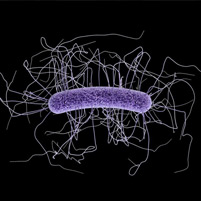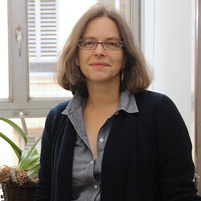Germ of an Idea

Illustration depicts Clostridium difficile, a spore-forming bacillus

Dannie Durand
Dannie Durand is working to understand how bacteria evolved in different ways to create spores that survive during tough times.
By learning how the mechanics behind the survival technique developed, the Carnegie Mellon University computational biologist and her colleagues hope one day to use that knowledge for future medical or agricultural applications.
Nearly three billion years ago, a group of bacteria thrived in the Earth's primitive oceans. They fed on chemicals in the water around them, adapting to different conditions and resources. When times got tough and resources were meager, they went into sleep mode by forming a spore — a tough structure that some bacteria use to survive during times of stress.
Today these bacteria's progeny are alive and well — and responsible for illnesses such as tetanus, botulism and anthrax.
These modern-day descendants of that long-ago ancestor have evolved in different ways to decide when to make spores. Durand is focusing on two classes of 21st century bacteria — the Clostridia and the Bacilli — to pinpoint the genes involved in their spore-making machinery and understand what their ancestor's spore-making proteins might have looked like.
"Our approach allows us not only to reconstruct what happened, but to ask how and why it happened the way it did," said Durand, associate professor in the departments of Biological Sciences and Computer Science, who is working on the project with John Pinney at Imperial College London and Michael Laub at MIT. The team recently received a Human Frontier Science Program grant.
Similar to evolutionary trees that show how cats, leopards and wolves are related, Durand's bacterial family trees will look at how several classes of bacteria are related. Her trees will only deal with a particular set of genes involved in the cell signaling pathway that instructs a bacterial cell to make a spore.
Cells contain many pathways that enable them to process information that is essential for survival, such as sensing their environment in order to respond to sudden changes. If, say, an anthrax bacillus receives a signal indicating lack of food, specific proteins will pass that message into the cell via a series of biochemical reactions, similar to how a relay team passes a baton from person to person. The cell responds by making a spore.
Clostridia and Bacilli have very similar spore-making machinery. But the ways that the bacteria understand when to make a spore are different — the Clostridia have a simple, two-protein signaling pathway while the Bacilli have a more complex four-protein signaling pathway.
"Clostridia and Bacilli are the only classes of bacteria that make spores like these, which suggests that their common ancestor also made spores," Durand said. "What did the ancestral pathway look like? Did it have two proteins or four? And how did the present-day pathways evolve from this ancestral pathway?"
The team's goal is to reverse engineer the ancient ancestor in the lab.
"What we see in today's proteins is what works. Nature is implicitly telling us what doesn't work," Durand said. "Understanding evolution provides us with an enormous amount of information about how we could manipulate cells ourselves for medical and agricultural applications, including bioremediation and biofuel development."
Related Links: Read the full story | Mellon College of Science | Biological Sciences | School of Computer Science
